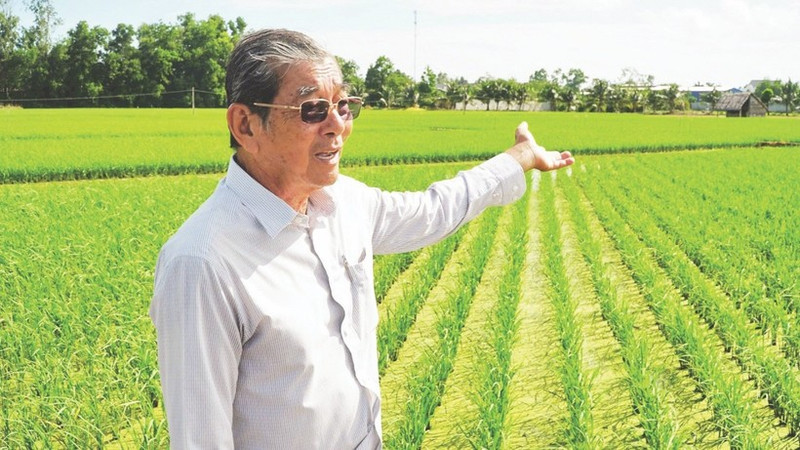Viet Nam’s rice: From hunger relief to “world’s best”
For generations, Vietnamese scientists have worked tirelessly alongside farmers in the fields to achieve remarkable progress in rice cultivation.

From the very first native rice varieties bred to shorten growing time and increase yields to fight hunger, today’s rice has elevated Viet Nam to one of the world’s leading rice exporters and the proud owner of the “world’s best rice”.
Tracing milestones in the scientific research of Vietnamese rice, it can be seen that the figure regarded as the “beginning” of the hybridisation journey of “made-in-Vietnam” rice and hailed as the “father” of the world’s best rice – both sharing the same homeland: Soc Trang (now in Can Tho) - the granary of the Mekong Delta.
The first agricultural doctor to “define” Vietnamese rice
Over 120 years ago, the French recognised the priceless value of Vietnamese rice upon arriving in Viet Nam. The legendary Xang Xa No Canal stands as proof of the first “rice road” built to export the fertile grains of the Mekong Delta. Records show that during the French colonial period, from 1921 to 1924, Viet Nam exported 1 million tonnes of rice annually, rising to 2 million tonnes in 1939.
Yet history also bears the haunting memory of the famine that killed over two million Vietnamese in 1945 – the “eve” of the August Revolution. It was the farmers who rose up to reclaim independence and freedom, realising the dream of producing rice on their ancestral fields. However, during the war years, rice output saw a sharp decline; by 1954, exports dropped to only 0.52 million tonnes. Amid war and poverty, in 1952, agronomist Luong Dinh Cua heeded President Ho Chi Minh’s call, returning from Japan to contribute to the nation’s revolutionary cause.
To address the urgent need to fight hunger, Luong Dinh Cua successfully bred short-duration, high-yield, and pest-resistant rice varieties. Southern Ba Thac rice was crossed with Japanese strains to produce Agricultural 1 rice for summer-autumn crops, while varieties like Chiem 314 suited low-lying areas, while Than Nong 307, NN75-1, NN8-388 increased yields by 20–30% over older varieties and resisted pests effectively.
Farmers of previous generations remember his pivotal role in promoting field bunding, in-field irrigation to enable intensive rice cultivation and multiple cropping, and introducing improved transplanting methods by applying Japanese experience to support local farmers. The revolution in changes of varieties and farming techniques he initiated raised average yields from 1.5 tonnes per ha to 5–6 tonnes per ha.
His legacy of over 40 crop varieties and numerous applied agricultural research projects laid the foundation for the rice sector’s future.
Taking Vietnamese rice to the pinnacle of the world
Not far from Luong Dinh Cua’s memorial house lies the ST Rice Research Farm of agronomist Ho Quang Cua. Sitting in his “rice-viewing hut” amid fields of the now-famous “beauty queen” ST varieties, from ST1 to ST25, Cua recounted how, from 1978–1993, he worked in the brackish-water district of My Xuyen, a land renowned not just for good rice, but fragrant rice. “Back then, rice was everywhere. Living among farmers, wandering the countryside, I fell in love with our local rice,” he shared.
His journey into fragrant and good rice breeding began in 2002, when he saw a gap in developing new varieties. Seeking distinction – aromatic rice, something no one had pursued – turned into an 18-year journey. “It was a long time in a lifetime, but I didn’t feel it because research was voluntary,” he said. The rice variety code, abbreviated from the two letters of Soc Trang and numbered from 1 to 25, is the result of an immense effort by him and his colleagues. The reward came when he finally created a rice with a fragrance unlike any other in the world.
“Through crossbreeding strains from the Mekong Delta with those from the Red River Delta, and crossing Oryza sativa Indiaca with Oryza sativa Japonica, combining southern pineapple-like aroma with northern young-rice scent, we developed a high-quality grain with a unique fragrance,” Cua explained.
On the world stage, the ST varieties reached the pinnacle of recognition. In 2017, ST24 was awarded “the world’s best rice” at the 9th World Rice Conference organised by The Rice Trader in Macao (China). Two years later, ST25 surpassed Thai varieties to claim first prize at the world’s best rice contest. In 2023, the ST25 brand was again honoured as the number one rice globally.
A story of nearly 50 years of trial rice fields
Another key figure in defining Vietnamese rice is the late Professor Vo Tong Xuan. Through tireless dedication to rice cultivation, he stands as an exemplary figure among rice scientists, having not only developed high-yield varieties such as IR8 and IR36 but also promoted improved wet-rice farming techniques across the country’s rice-growing regions.
In 1972, when brown planthoppers ravaged fields, he sourced and multiplied IR26 and IR30 varieties. A pioneer in modern farming practices, he proposed the “large-scale field” model and the “five-house” linkage to boost production efficiency and ensure stable outlets, thereby raising the value of Vietnamese rice.
Today, Viet Nam’s rice yields are the highest in Southeast Asia, at 5–7 tonnes per ha, nearly double Thailand’s and one and a half times India’s. Vietnamese rice is present in 150 countries and territories. Yet even superior varieties typically have a lifespan of only about five years before declining, making ongoing research crucial to preserve their advantages and adapt to climate, soil, and pests.
The Mekong Delta Rice Institute, surveyed and founded by Luong Dinh Cua in 1976, remains where generations of scientists dedicate themselves to each variety’s lifecycle.
Passionately recounting the nearly 50-year history of experimental rice fields, Dr Tran Ngoc Thach, Director of the Mekong Delta Rice Institute, drew into his enduring love and unwavering dedication to rice. The institute must continuously develop varieties of equal or superior quality with better pest resistance to replace those that inevitably degenerate. In addition, it creates new varieties to meet the diverse demands of domestic and export markets. “We focus our research on rice quality, including the taste of cooked rice, nutritional value, consumer perception, while ensuring low cultivation costs, high yields, and adaptability to climate change,” Dr Thach shared.
Leading us to a 30-hectare rice field, he pointed to each plot marked with detailed signs and explained: “This one has had no fertiliser for nearly 50 years; that one only nitrogen; others only phosphate or potassium… to test how the soil changes and degrades over time. Each rice variety is planted uniformly on a single plot, helping us better understand the effects of factors such as fertiliser and environmental conditions on rice growth. The sustainable farming model also began here.”
Leaving the Mekong Delta Rice Institute – a “living museum” of the rice journey over the past half-century – I was reminded of agronomist Ho Quang Cua’s words: “From escaping famine, improving rice varieties and cultivation to fight hunger, in the latter half of these eight decades since Independence Day, Viet Nam has exported enough rice to feed billions worldwide. Such a phenomenal leap was made possible by thousands of Vietnamese scientists, starting with Academician Luong Dinh Cua, who toiled under extremely harsh and deprived conditions.”
And surely, this journey will be continued by generations of agricultural scientists, steadfastly moving towards the future.








